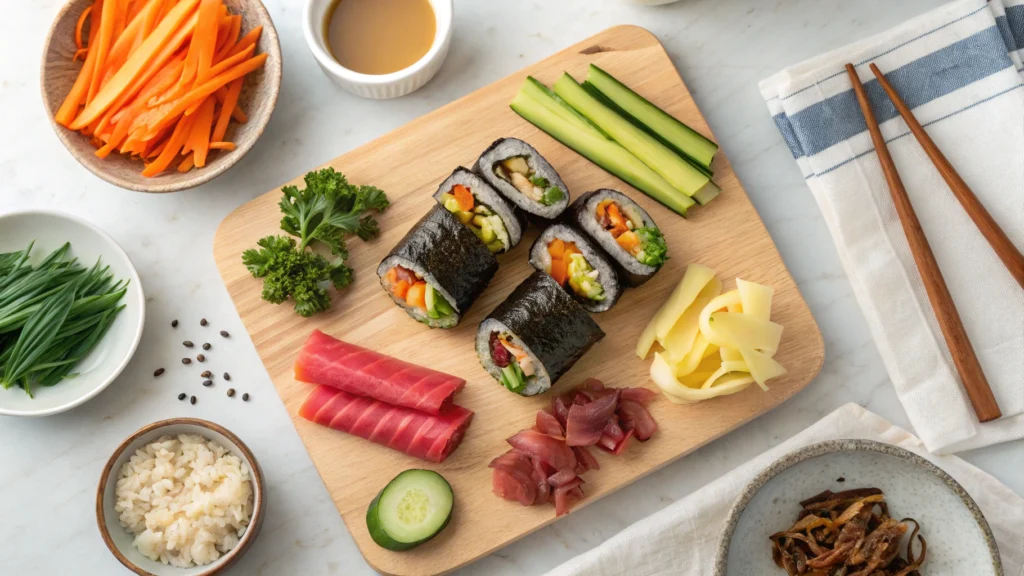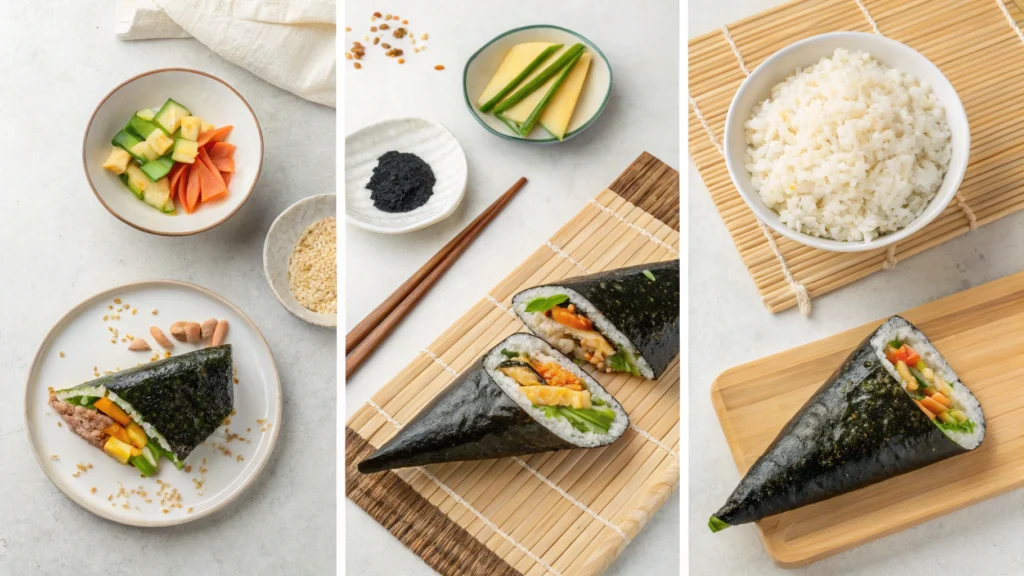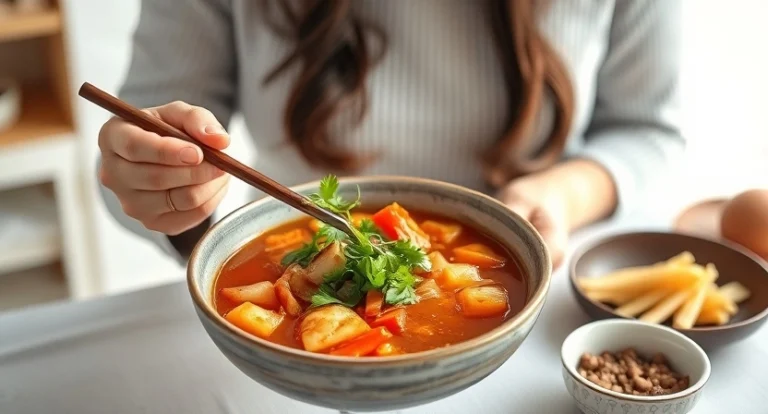5 Essential Tips to Make Perfect Korean Triangle Kimbap at Home
Master the art of making delicious Korean triangle kimbap at home with our 5 essential tips! Learn to make this popular and fun dish.
Introduction
Have you ever craved a quick, satisfying, and incredibly delicious snack or meal? Then, look no further than Samgak Kimbap, the iconic triangle-shaped seaweed rice roll that’s beloved in Korea and is increasingly gaining popularity worldwide. You’ve probably seen them at your local Korean market or even tried one on a whim, and now you’re wondering how to make these tasty treats at home. Well, you’re in luck! This article will walk you through the five essential tips to create perfect, authentic-tasting triangle kimbap right in your own kitchen. Therefore, instead of relying on store-bought options, you can now confidently craft these flavorful delights anytime the craving strikes.
Triangle kimbap, or samgak kimbap, is more than just a meal; it’s a testament to Korean culinary ingenuity. It is a convenient grab-and-go option and its portable format makes it perfect for lunchboxes, picnics, or a quick snack. Making it at home not only allows you to tailor the fillings to your personal preferences but is also a cost-effective way to enjoy this beloved Korean staple. In addition, mastering triangle kimbap allows you to explore Korean flavors. So, whether you’re a seasoned cook or a complete beginner, our comprehensive guide will provide you with the knowledge and tips to create restaurant-quality kimbap. Let’s embark on this delicious journey together!

Understanding the Fundamentals of Kimbap
Before we dive into the tips, it is essential to understand the core elements of kimbap. Therefore, let’s break down the essential building blocks that make a delicious kimbap.
The Importance of Rice for Kimbap
The heart of kimbap lies in its rice. In fact, the type of rice you use significantly impacts the final texture and taste of your kimbap. Short-grain or medium-grain rice is the best choice, because these types of rice have the perfect amount of starch to create the slightly sticky texture essential for kimbap. However, long-grain rice, on the other hand, will not hold together as well, making it hard to form the rolls.
Therefore, to prepare the rice perfectly, start by rinsing the rice thoroughly under cold water until the water runs clear to remove excess starch. Next, cook the rice with the correct water-to-rice ratio according to your chosen cooking method (either on the stove or using a rice cooker). Then, once cooked, it’s crucial to season the rice with a mixture of rice vinegar, sugar, and salt. This seasoning adds a subtle tang and sweetness that beautifully complements the other ingredients. Finally, remember to let the rice cool down slightly before you use it for kimbap. This step prevents it from becoming too sticky and mushy when assembling.
The Nori (Seaweed) Factor
Another key ingredient for kimbap is nori – the dried seaweed sheets. These sheets are roasted and have a slightly salty taste, which adds a unique umami flavor to the rolls. However, make sure you get the right type of nori, which is specifically made for kimbap or sushi. In addition, to maintain their crispness, store nori in an airtight container and in a dry place.
Essential Fillings for Kimbap
The beauty of kimbap is its versatility when it comes to fillings. You have the freedom to choose your favorite ingredients! The possibilities are endless but here are some popular choices:
- Vegetables: Common choices include carrots, which are often julienned and lightly sauteed; spinach, usually blanched; pickled radish (danmuji), which adds a burst of tangy flavor; and cucumber, sliced into strips.
- Proteins: Many protein options enhance the flavor and texture of your kimbap, for example: canned tuna, drained and mixed with a bit of mayonnaise; bulgogi (Korean BBQ beef), sliced thinly; crab sticks, cut into strips; or even spam, lightly pan-fried.
- Egg: Sliced hard-boiled egg or a thin egg omelet adds richness and protein to your kimbap.
Therefore, when preparing your chosen fillings, make sure they are cut into even pieces, making it easier to assemble the rolls.
Tip #1: Mastering the Art of Perfectly Seasoned Rice
Achieving the correct seasoning in the rice is the first key step to making great kimbap. The seasoning mixture is what gives the rice its slightly tangy and sweet flavor, which is essential for balancing the other ingredients.
Precise Measurements for Seasoned Rice
The precise ratio of rice vinegar, sugar, and salt is crucial for the perfect flavor. Generally, for every 3 cups of cooked rice, you will need 2 tablespoons of rice vinegar, 1.5 tablespoons of sugar, and 1 teaspoon of salt. In addition, it is important to measure all the ingredients accurately because it will affect the flavor.
Making the Seasoning Mixture
Therefore, to prepare the seasoning, first, combine the rice vinegar, sugar, and salt in a small bowl. Stir until the sugar and salt are completely dissolved. You can also microwave the mixture for 20 seconds for the salt and sugar to dissolve more easily. However, if you prefer a slightly sweeter or more sour flavor, feel free to adjust the ratios to your liking.
Incorporating the Seasoning
Once the seasoning is ready, gently fold it into the warm rice. Therefore, use a cutting motion with a rice paddle or spatula to avoid mashing the rice. In addition, make sure to evenly distribute the seasoning throughout the rice. Finally, let the rice cool down at room temperature, spreading it out on a large, clean surface to facilitate cooling and prevent it from clumping. As a result, the rice should be slightly sticky but not mushy.
Tip #2: Choosing and Preparing the Best Fillings for your Triangle Kimbap
The fillings you choose significantly impact the overall flavor and texture of your kimbap. Therefore, carefully selected and prepared fillings are crucial for creating delicious samgak kimbap.

Quality of Ingredients
Always prioritize fresh and high-quality ingredients. Therefore, using the best ingredients makes a big difference.
Preparation Techniques for Different Fillings
First, prepare your vegetables by blanching the spinach, julienning the carrots, and thinly slicing the cucumbers. Then, you can prepare the protein by draining and mixing canned tuna with mayonnaise, marinating and cooking your bulgogi, cutting the crab sticks into strips, or lightly pan-frying your spam. Finally, for the egg, you can make a thin omelet and slice it or use it as scrambled egg.
Cutting and Shaping Fillings
Cut your fillings into even strips or pieces that fit within the triangle shape. This makes the assembly process easier and ensures the flavors and textures are well balanced.
Preventing Soggy Kimbap
To prevent soggy kimbap, always pat down any wet ingredients, ensuring no excess moisture will be trapped inside.
Balance and Flavor Profiles
Choose a variety of fillings that provide a balance of flavors and textures. For example, a combination of savory ingredients, crunchy vegetables, and soft protein will create an enjoyable eating experience. In addition, don’t be afraid to experiment with flavors to create your favorite kimbap variation.
Tip #3: The Right Tools and Equipment for Success
Using the right tools will make the process of making kimbap at home easier and more efficient. Therefore, let’s explore the essential tools and equipment that you should consider to make perfect samgak kimbap.
Triangle Kimbap Molds
The most essential tool is, without doubt, a triangle kimbap mold. These molds make it easy to shape the kimbap perfectly every time and also create a uniform shape. Several different types of molds are available, for example plastic or silicone, so you can pick the one that you like best. In addition, they are usually available at Korean grocery stores, online retailers, or at many large supermarkets.

Rice Paddle (Shamoji)
A rice paddle, or shamoji, is a useful tool to handle the rice. Unlike a spoon, it prevents the rice from getting mashed. In addition, it’s useful for spreading the rice evenly and gently folding in the seasoning.
Sharp Knife or Kitchen Scissors
Therefore, for cutting nori sheets or cutting your finished kimbap, always have a sharp knife or kitchen scissors ready.
Cutting Board or Clean Surface
A clean cutting board or surface will prevent the rice from sticking to the counter. As a result, your surface will be neat.
Optional Tools
If you don’t have a mold, a clean plastic wrap can come in handy to help form the kimbap and prevent the rice from sticking to your hands.
Tip #4: Assembling the Perfect Triangle Kimbap
Now that you’ve prepped all your ingredients and gathered your tools, it’s time to put everything together. Therefore, let’s get into assembling the kimbap.
Mold Preparation
If using a mold, slightly moisten it with water to prevent the rice from sticking. However, if you are using plastic wrap instead, set it on your clean surface.
Layering the Ingredients Step-by-Step
First, start by spreading a thin, even layer of rice on the bottom of the mold or plastic wrap. Next, create a central line or layer with your chosen fillings. Then, cover the fillings with another layer of rice. Finally, if you are using a mold, firmly close the mold and press gently to secure the ingredients. However, if you are using plastic wrap, carefully gather all the edges to seal and form a triangle shape, also pressing gently to secure the ingredients.
Pressing Gently
Therefore, gently press the kimbap to ensure the rice and fillings are well combined. This step is important to ensure that all ingredients stick together.
Removal from Mold
Finally, carefully remove the kimbap from the mold to avoid breaking it. If you are using plastic wrap, slowly peel it off, keeping the shape intact.
Achieving Uniformity
When assembling kimbap, always strive for consistency. Therefore, use a consistent amount of filling in each roll to ensure even flavor and texture in every bite.
Wrapping
If wrapping with additional plastic wrap for storage or carrying, be sure to wrap them tightly to keep the shape and prevent them from drying out.
Tip #5: Presentation, Serving, and Storage
After assembling your kimbap, presentation, serving, and storage are equally important to maintain the quality and appeal of your culinary creation. Therefore, let’s discuss how to best present, serve and store your kimbap.
Cutting the Kimbap
If you did not already make your kimbap bite-sized, cut each triangle kimbap in half. Therefore, make sure you use a sharp knife, slightly dampening the blade to prevent sticking.
Presentation
When serving kimbap, arrange the halves nicely on a plate, in a lunchbox, or even in a bento box. For example, add a sprinkle of sesame seeds or a drizzle of sesame oil for a touch of elegance.
Storage Options
For short-term storage, you can keep them at room temperature for a few hours. However, for longer storage, place them in the refrigerator to keep them fresh. When reheating, remember to warm them gently so they do not dry out. However, if you need to freeze your kimbap, be sure to thaw them correctly so they maintain their texture.
Best Enjoyment
Kimbap is always best enjoyed soon after it’s made. This will ensure the rice is still moist and the nori is still crispy.
Variations and Customization
The great thing about kimbap is that it is a versatile dish that lends itself perfectly to all types of customizations and variations. Therefore, let’s explore different ways to tailor kimbap to your personal preferences.
Different Filling Ideas
Feel free to get creative with your choice of fillings. For example, consider adding kimchi for a spicy kick or try different types of vegetables or proteins.
Vegan Options
For a vegan kimbap version, use plant-based substitutes for protein fillings. For instance, you can use marinated tofu or sauteed mushrooms.
Spicy Variations
If you prefer a spicy version, add a touch of gochujang to the fillings or mix it in with the rice.
Kid-Friendly Options
For a kid-friendly version of kimbap, choose fillings that are popular among children, such as egg, mild vegetables, or seasoned proteins.
Detailed Recipe for Triangle Kimbap
Here is a detailed recipe to guide you through making triangle kimbap:
Ingredients:
- 3 cups cooked short-grain or medium-grain rice
- 2 tablespoons rice vinegar
- 1.5 tablespoons sugar
- 1 teaspoon salt
- 4-5 sheets of roasted nori (seaweed)
- 1/2 cup julienned carrots, lightly sautéed
- 1/2 cup spinach, blanched
- 1/4 cup pickled radish (danmuji), sliced
- 1/4 cup cucumber, sliced into strips
- 1/2 cup canned tuna, drained and mixed with mayonnaise
- Optional: sesame oil, sesame seeds, or extra fillings of your choice

Instructions:
- Cook the Rice: Rinse the rice under cold water until the water runs clear. Cook the rice according to package directions or using your preferred method.
- Prepare Seasoning: In a small bowl, combine rice vinegar, sugar, and salt. Stir until sugar and salt dissolve.
- Season the Rice: Gently fold the seasoning mixture into the warm, cooked rice using a cutting motion with a rice paddle. Spread the rice on a clean surface to cool down.
- Prepare Fillings: Prepare the vegetables, proteins, and eggs according to the tips described above. Cut all ingredients into thin strips.
- Prepare Your Workspace: Get your kimbap mold, rice paddle, knife or scissors ready.
- Assemble the Kimbap: If using a mold, moisten it slightly to prevent sticking. If you are using plastic wrap, place it on your clean surface.
- Layer Ingredients: Spread a thin layer of rice in the bottom of the mold or plastic wrap. Add a layer of your fillings in the center. Cover the fillings with another layer of rice.
- Seal and Press: If using a mold, press the mold gently. If using plastic wrap, gather the edges to seal and gently press.
- Remove and Cut: Carefully remove the kimbap from the mold or remove the plastic wrap. Cut the kimbap in half if desired.
- Serve and Enjoy: Arrange your kimbap on a plate or in a lunchbox. Enjoy your delicious homemade triangle kimbap!
Nutritional Information
Nutritional Content (per 100g, approximate):
| Nutrient | Amount |
| Calories | 150-180 |
| Protein | 5-7g |
| Fat | 3-5g |
| Carbohydrates | 25-30g |
| Fiber | 2-3g |
| Sodium | 200-300mg |
Note: Nutritional values can vary based on the specific ingredients and amounts used.
FAQ
Q: Where can I buy triangle kimbap?
A: Samgak kimbap is readily available at most Korean supermarkets, convenience stores, and some Asian grocery stores. They are often found in the refrigerated section, ready-to-eat.
Q: What is Samgak kimbap?
A: Samgak kimbap is a popular Korean seaweed rice roll that’s shaped into a triangle, often filled with various ingredients. It’s a convenient grab-and-go meal or snack.
Q: Do you have a good kimbap triangle recipe?
A: Yes, our article above provides a detailed recipe and step-by-step instructions on how to make perfect samgak kimbap at home.
Q: How is Samgak kimbap different from onigiri?
A: While both are rice-based snacks wrapped in seaweed, samgak kimbap (Korean) uses seasoned rice and various fillings. Onigiri (Japanese) is typically shaped into triangles or balls and has a simple filling like pickled plum or grilled salmon.
Q: Is there a spicy variation of samgak kimbap?
A: Yes! A popular variation is samgak kimbap kimchi, which includes kimchi as one of the fillings for an extra spicy and tangy kick.
Q: Can you make tuna kimbap at home?
A: Yes! Our recipe includes tuna mixed with mayonnaise as a great choice for a delicious tuna kimbap.
Q: What is Korean dosirak?
A: Dosirak is a Korean packed lunch, often including kimbap or other rice dishes, along with various side dishes, perfect for meals on the go.
Q: Can you share a basic kimbap recipe?
A: Absolutely! Our article has a full kimbap recipe, and comprehensive step-by-step instructions for making both a regular roll and a triangle version!
Conclusion
Making perfect triangle kimbap at home might seem daunting at first, but with our 5 essential tips, you’ll be creating delicious, authentic-tasting kimbap in no time. Therefore, remember to use the right type of rice, season it well, choose your fillings carefully, use the right tools, and assemble your kimbap with care. Finally, now that you know all the secrets, go ahead, give it a try, and enjoy your homemade creations! Therefore, please feel free to share your comments below, or share your homemade creation.
Cooking is an act of love and creativity! 🌟 What do you think of this recipe? I’d love to hear your thoughts and any tips or tweaks you’d suggest to make it even better. Let’s inspire each other in the kitchen!
There are no reviews yet. Be the first one to write one.








